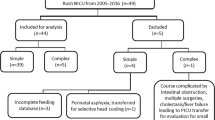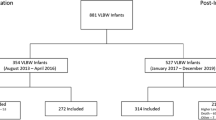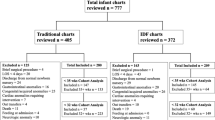Abstract
Objective
To describe the prevalence and patterns of gestational parent’s own milk (GPOM) feedings among infants undergoing major surgery during their neonatal intensive care unit (NICU) admission.
Study Design
We analyzed de-identified electronic medical records of all infants admitted to a regional NICU 2014–2015 who underwent surgery for a gastrointestinal, cardiac, or other major organ system defect(s).
Results
Of 79 infants, 85% received any GPOM during the NICU hospitalization. The median proportion of GPOM feeds was 66%. There was a trend toward decreassing proportions of GPOM with progressive months in NICU. The rate of any and exclusive GPOM feeds at NICU discharge was 49% and 29%, respectively. Infants who had a GI anomaly were more likely than infants with a cardiac anomaly to be discharged from NICU receiving GPOM.
Conclusion
Barriers to the exclusive and continued provision of GPOM in this population require further study and intervention.
This is a preview of subscription content, access via your institution
Access options
Subscribe to this journal
Receive 12 print issues and online access
$259.00 per year
only $21.58 per issue
Buy this article
- Purchase on Springer Link
- Instant access to full article PDF
Prices may be subject to local taxes which are calculated during checkout

Similar content being viewed by others
References
American Academy of Pediatrics Section on Breastfeeding. Breastfeeding and the use of human milk. Pediatrics. 2012;129:e827–41.
Miller J, Tonkin E, Damarell RA, McPhee AJ, Suganuma M, Suganuma H, et al. A systematic review and meta-analysis of human milk feeding and morbidity in very low birth weight infants. Nutrients. 2018;10:707. https://doi.org/10.3390/nu10060707.
Gulack BC, Laughon MM, Clark RH, Burgess T, Robinson S, Muhammad A, et al. Enteral feeding with human milk decreases time to discharge in infants following gastroschisis repair. J Pediatr. 2016;170:85–9.
Haug S, St Peter S, Ramlogan S, Goff D, Thorpe D, Hopper A, et al. Impact of breast milk, respiratory insufficiency and gastroesophageal reflux disease on enteral feeding in infants with omphalocele. J Pediatr Gastroenterol Nutr. 2016;68:e94–8.
Kohler JA Sr., Perkins AM, Bass WT. Human milk versus formula after gastroschisis repair: effects on time to full feeds and time to discharge. J Perinatol. 2013;33:627–30.
Groer MW, Luciano AA, Dishaw LJ, Ashmeade TL, Miller E, Gilbert JA. Development of the preterm infant gut microbiome: a research priority. Microbiome. 2014;2:38.
Victora CG, Bahl R, Barros AJ, Franca GV, Horton S, Krasevec J, et al. Breastfeeding in the 21st century: epidemiology, mechanisms, and lifelong effect. Lancet. 2016;387:475–90.
Shoji H, Shimizu T, Shinohara K, Oguchi S, Shiga S, Yamashiro Y. Suppressive effects of breast milk on oxidative DNA damage in very low birthweight infants. Arch Dis Child Fetal Neonatal Ed. 2004;89:F136–8.
de Halleux V, Pieltain C, Senterre T, Studzinski F, Kessen C, Rigo V, et al. Growth benefits of own mother’s milk in preterm infants fed daily individualized fortified human milk. Nutrients. 2019;11:772.
Montjaux-Regis N, Cristini C, Arnaud C, Glorieux I, Vanpee M, Casper C. Improved growth of preterm infants receiving mother’s own raw milk compared with pasteurized donor milk. Acta Paediatr. 2011;100:1548–54.
Peila C, Moro GE, Bertino E, Cavallarin L, Giribaldi M, Giuliani F, et al. The effect of Holder pasteurization on nutrients and biologically-active components in donor human milk: a review. Nutrients. 2016;8:477.
Purdy IB, Singh N, Le C, Bell C, Whiteside C, Collins M. Biophysiologic and social stress relationships with breast milk feeding pre- and post-discharge from the neonatal intensive care unit. J Obstet Gynecol Neonatal Nurs. 2012;41:347–57.
Rendon-Macias ME, Castaneda-Mucino G, Cruz JJ, Mejia-Arangure JM, Villasis-Keever MA. Breastfeeding among patients with congenital malformations. Arch Med Res. 2002;33:269–75.
Demirci J, Caplan E, Brozanski B, Bogen D. Winging it: maternal perspectives and experiences of breastfeeding newborns with complex congenital surgical anomalies. J Perinatol. 2018;38:708–17.
Froh EB, Deatrick JA, Curley MA, Spatz DL. Making meaning of pumping for mothers of infants with congenital diaphragmatic hernia. J Obstet Gynecol Neonatal Nurs. 2015;44:439–49.
Salvatori G, Foligno S, Massoud M, Piersigilli F, Bagolan P, Dotta A. The experience of breastfeeding infants affected by congenital diaphragmatic hernia or esophageal atresia. Ital J Pediatrics. 2018;44:75.
Barbas KH, Kelleher DK. Breastfeeding success among infants with congenital heart disease. Pediatr Nurs. 2004;30:285–9.
Spatz DL, Froh EB. human milk and breastfeeding outcomes in infants with myelomeningocele. Adv Neonatal Care. 2019;19:376–82.
Spatz DL, Froh EB, Bartholomew D, Edwards T, Wild KT, Hedrick H, et al. Lactation experience of mothers and feeding outcomes of infants with congenital diaphragmatic hernia. Breastfeed Med. 2019;14:320–4.
Edwards TM, Spatz DL. An innovative model for achieving breast-feeding success in infants with complex surgical anomalies. J Perinat Neonatal Nurs. 2010;24:246–53. quiz 254-45.
Martino K, Wagner M, Froh EB, Hanlon AL, Spatz DL. Postdischarge breastfeeding outcomes of infants with complex anomalies that require surgery. J Obstet Gynecol Neonatal Nurs. 2015;44:450–7.
Torowicz DL, Seelhorst A, Froh EB, Spatz DL. Human milk and breastfeeding outcomes in infants with congenital heart disease. Breastfeed Med. 2015;10:31–37.
Davanzo R, Monasta L, Ronfani L, Brovedani P, Demarini S. Breastfeeding at NICU discharge: a multicenter Italian study. J Hum Lact. 2013;29:374–80.
Ericson J, Flacking R, Hellstrom-Westas L, Eriksson M. Changes in the prevalence of breast feeding in preterm infants discharged from neonatal units: a register study over 10 years. BMJ Open. 2016;6:e012900.
Froh EB, Deatrick JA, Curley MAQ, Spatz DL. Mothers of infants with congenital diaphragmatic hernia describe “breastfeeding” in the neonatal intensive care unit: “As long as it’s my milk, I’m happy”. J Hum Lact. 2017;33:524–32.
Spatz DL. Ten steps for promoting and protecting breastfeeding for vulnerable infants. J Perinat Neonatal Nurs. 2004;18:385–96.
Nyqvist KH, Haggkvist AP, Hansen MN, Kylberg E, Frandsen AL, Maastrup R, et al. Expansion of the baby-friendly hospital initiative ten steps to successful breastfeeding into neonatal intensive care: expert group recommendations. J Hum Lact. 2013;29:300–9.
Meier PP, Patel AL, Bigger HR, Rossman B, Engstrom JL. Supporting breastfeeding in the neonatal intensive care unit: Rush Mother’s Milk Club as a case study of evidence-based care. Pediatr Clin North Am. 2013;60:209–26.
Sharma R, Hudak ML. A clinical perspective of necrotizing enterocolitis: past, present, and future. Clin Perinatol. 2013;40:27–51.
Cognata A, Kataria-Hale J, Griffiths P, Maskatia S, Rios D, O’Donnell A, et al. Human milk use in the preoperative period is associated with a lower risk for necrotizing enterocolitis in neonates with complex congenital heart disease. J Pediatr. 2019;215:11–16.e12.
Centers for Disease Control and Prevention National Immunization Survey. Rates of any and exclusive breastfeeding by socio-demographics, among children born in 2016. 2019; https://www.cdc.gov/breastfeeding/data/nis_data/rates-any-exclusive-bf-socio-dem-2016.htm. Accessed 30 June 2020.
Robinson K, Fial A, Hanson L. Racism, bias, and discrimination as modifiable barriers to breastfeeding for African American women: a scoping review of the literature. J Midwifery Women’s Health. 2019;64:734–42.
Hoban R, Bigger H, Patel AL, Rossman B, Fogg LF, Meier P. goals for human milk feeding in mothers of very low birth weight infants: how do goals change and are they achieved during the NICU hospitalization? Breastfeed Med. 2015;10:305–11.
Patel AL, Schoeny ME, Hoban R, Johnson TJ, Bigger H, Engstrom JL, et al. Correction: Mediators of racial and ethnic disparity in mother’s own milk feeding in very low birth weight infants. Pediatr Res. 2019;86:786.
Rossman B, Meier PP, Spatz DL. A wake-up call: persistent barriers to the provision of evidence-based lactation support and education in the NICU. J Perinatol. 2018;38:773–4.
Spatz DL. Beyond BFHI: the spatz 10-step and breastfeeding resource nurse model to improve human milk and breastfeeding outcomes. J Perinat Neonatal Nurs. 2018;32:164–74.
Kataria-Hale J, Roddy DJ, Cognata A, Hochevar P, Zender J, Sheaks P, et al. A preoperative standardized feeding protocol improves human milk use in infants with complex congenital heart disease. J Perinatol. 2021;41:590–7.
Acknowledgements
Data acquisition was supported through NIH grant UL1TR001857. We thank Debra L. Bogen for her support in project conceptualization. We also thank Erin Caplan and Nora Lee for their assistance with dataset preparation.
Funding
This study was funded by the Association of Women’s Health, Neonatal, and Obstetric Nurses (Kimberly-Clark Nursing Research Award; PI: Demirci).
Author information
Authors and Affiliations
Contributions
JRD contributed to the conceptualization and design of the analysis, the analysis itself, and drafted the initial manuscript. JD assisted with data interpretation. MG assisted with data analysis. BB assisted with data acquisition and interpretation. All authors were involved in critically revising the manuscript for intellectual content and approved the final version.
Corresponding author
Ethics declarations
Ethics approval
This study was approved by the University of Pittsburgh Institutional Review Board and performed in accordance with the Declaration of Helsinki.
Competing interests
The authors declare no competing interests.
Additional information
Publisher’s note Springer Nature remains neutral with regard to jurisdictional claims in published maps and institutional affiliations.
Supplementary information
Rights and permissions
About this article
Cite this article
Demirci, J.R., Davis, J., Glasser, M. et al. Prevalence and patterns of gestational parent’s own milk feeds among infants with major congenital surgical anomalies in the NICU. J Perinatol 41, 2782–2788 (2021). https://doi.org/10.1038/s41372-021-01176-6
Received:
Revised:
Accepted:
Published:
Issue Date:
DOI: https://doi.org/10.1038/s41372-021-01176-6



